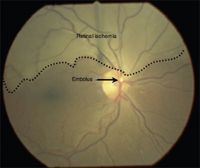
Photo from wikipedia
OBJECTIVE The atherosclerotic plaque is a complex dynamic pathological lesion of the arterial wall, characterized by multiple elementary lesions of different diagnostic and prognostic significance. Fibrous cap thickness, lipid necrotic… Click to show full abstract
OBJECTIVE The atherosclerotic plaque is a complex dynamic pathological lesion of the arterial wall, characterized by multiple elementary lesions of different diagnostic and prognostic significance. Fibrous cap thickness, lipid necrotic core dimension, inflammation, intra-plaque hemorrhage (IPH), plaque neovascularization and endothelial dysfunction (erosions) are generally considered the most relevant morphological details of plaque morphology. In this review, the most relevant features able to discriminate between stable and vulnerable plaques at histological level are discussed. SUBJECTS AND METHODS Retrospectively, we have evaluated the laboratory results from one hundred old histological samples from patients treated with carotid endarterectomy. These results were analyzed to assess elementary lesions that characterize stable and unstable plaques. RESULTS A thin fibrous cap (<65 micron), loss of smooth muscle cells, collagen depletion, a large lipid-rich necrotic core, infiltrating macrophages, IPH and intra-plaque vascularization are identified as the most important risk factors associated with plaque rupture. CONCLUSIONS Immunohistochemistry for smooth muscle actin (smooth muscle cell marker) and for CD68 (marker of monocytes/macrophages) and glycophorin (marker of red blood cells) are suggested as useful tools for an in deep characterization of any carotid plaque and for distinguishing plaque phenotypes at histology. Since patients with a carotid vulnerable plaque are at higher risk of developing vulnerable plaques in other arteries as well, the definition of the vulnerability index is underlined, in order to stratify patients at higher risk for undergoing cardiovascular events.
Journal Title: European review for medical and pharmacological sciences
Year Published: 2023
Link to full text (if available)
Share on Social Media: Sign Up to like & get
recommendations!